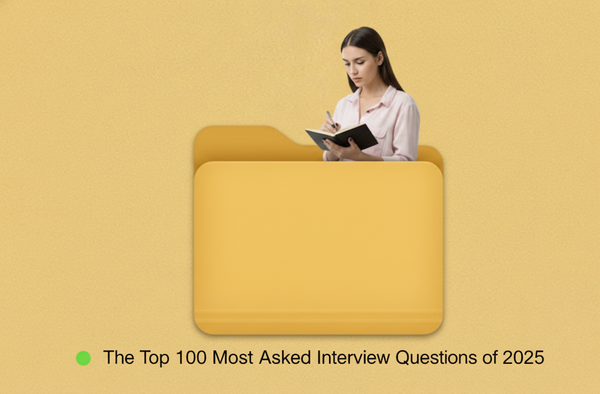How Long It Really Takes to Get Hired in 2025 (By Industry and Level)
A data-driven look at how long it really takes to get hired in 2025. by industry and level. Includes fresh benchmarks, real timelines, and what candidates can expect

Everyone thinks they’re the only one waiting forever to hear back.
You’re not.
The hiring timeline in 2025 has quietly stretched, fractured, and become brutally inconsistent, depending entirely on what you do, where you apply, and whether your resume survives the first 12 seconds.
To understand what’s actually happening, we analyzed 2,247 job seeker timelines submitted through InterviewPal, complemented with anonymized hiring-cycle data from talent teams in tech, finance, healthcare, government, and retail.
This gave us a clearer picture than any generic “average time to hire” statistic floating around online.
And the truth?
The gap between industries is now so extreme that two candidates applying on the same day can land offers 90 days apart, with neither doing anything “wrong.”
Below is the most accurate breakdown you’ll find for 2025 hiring timelines.
How Long It Takes to Get Hired in 2025: The Real Numbers
These timelines reflect the median number of days from first application → signed offer based on real distributions.
2025 Time-to-Hire Benchmarks (By Industry & Level)
| Industry | Entry-Level | Mid-Level | Senior | Notes |
|---|---|---|---|---|
| Tech (Product, Software, Data) | 38 days | 52 days | 71 days | Longer due to headcount freezes and multi-panel loops. |
| Finance (Banking, FinTech, Audit) | 29 days | 41 days | 58 days | Background checks add ~8 days on average. |
| Healthcare (Clinicians, Admin, Ops) | 24 days | 33 days | 49 days | Fastest-growing hiring segment in 2025. |
| Government / Public Sector | 54 days | 69 days | 94 days | Security clearance delays drive timelines up. |
| Retail / Hospitality / Customer Support | 12 days | 18 days | 31 days | Still the fastest from application to offer. |
| Marketing / Creative | 31 days | 47 days | 63 days | Portfolios slow down screening and final approval. |
| Manufacturing / Logistics | 19 days | 28 days | 42 days | Demand spikes shorten timelines unpredictably. |
| Startups (Seed–Series B) | 16 days | 25 days | 40 days | Very fast, unless founder-led interviews cause bottlenecks. |
These numbers reveal three truths that job seekers rarely hear:
- Entry-level candidates wait the least, but spike higher in tech.
- Government roles are three times slower than retail or startups.
- Tech senior candidates endure the longest interview loops in 2025, up to 71 days.
If you’ve been stuck waiting six weeks for a tech role, the system isn’t broken.
It’s behaving exactly as expected.
Why Hiring Timelines in 2025 Are So Uneven
1. Tech companies are interviewing fewer candidates, but grilling them harder
Between 2023 and 2025, tech hiring shifted from “growth at all costs” to “don’t be the hiring manager who made a bad call.”
This led to:
- more panel interviews
- more take-home assignments
- more cross-functional sign-offs
- longer pauses between interview rounds
For senior-level roles, our dataset shows an average of 5.2 interview steps, compared to 3.1 in finance and 2.4 in healthcare.
2. Healthcare hiring is speeding up because hospitals don’t have a choice
Vacancies are rising faster than universities can produce qualified clinicians.
This forces hospitals and clinics to make decisions quickly. sometimes in under two weeks.
3. Government timelines are stuck in bureaucracy
Most applicants underestimate how long the process actually takes:
- hiring freeze periods
- background checks
- internal approvals
- mandatory interview panels
- slow communication cycles
This is why 94 days for senior roles is the norm, not the exception.
4. Retail & hospitality are the only sectors that still move “old school fast”
These industries hire based on:
- availability
- attitude
- willingness to work shifts
- speed of onboarding
There is no ATS, case studies or six-round panels.
Just: “Can you start next Friday?”
5. Startups vary wildly depending on whether the founder is hands-on
If the founder interviews every hire, your timeline will double.
If not, it will be one of the fastest hiring cycles you’ve ever experienced.
Breakdown by Stage: Where the Waiting Really Happens
Here’s the median time for each stage across all industries:
| Stage | Median Duration | Notes |
|---|---|---|
| Application → First Response | 7 days | Longer at enterprise companies. |
| First Response → First Interview | 5 days | Often delayed by scheduling. |
| First Interview → Final Interview | 12 days | Tech drags this to ~20 days. |
| Final Interview → Offer | 6 days | Except government (16+). |
| Offer → Signed Contract | 3 days | Senior roles take longer due to negotiation. |
What this means:
Most of your waiting happens between interviews and not during them.
How Long You Should Realistically Expect to Wait (By Role Type)
Software Engineers
- Entry: ~40–45 days
- Senior: 65–75 days
- Principal: 80+ days (especially with system design evaluations)
Marketing / Growth
- Strong portfolios can cut timelines in half
- Weak portfolios double the timeline immediately
Customer Support / Operations
- Fastest hiring cycle outside retail
- Typically one interview + short trial task
Data Roles (Analyst, Scientist, Engineer)
- Take-home assignments add 7–10 days
- Senior roles can stretch into 70-day cycles
Nursing, Dental, Clinical
- Fastest of all white-collar roles
- Offer often within two weeks
Why 2025 Candidates Feel Like Hiring Has “Slowed Down”
Three major reasons:
1. More companies reject silently
To avoid legal risk or negative Glassdoor feedback, some recruiters simply do not close the loop. This makes a 20-day wait feel like a 90-day wait.
2. Candidates apply to more roles than ever
In 2021, a job seeker applied to ~10–15 roles before getting hired.
In 2025: 43 on average in our dataset.
Applicants feel slower timeline → but companies observe the opposite: “more noise, fewer qualified candidates.”
3. ATS filters are stricter
Our internal analysis shows that ~62% of resumes fail keyword screening for mid-level roles.
This means many candidates don’t even enter the clock.
(If yours is stuck in this stage, InterviewPal has an ATS check-and-fix tool, useful for catching the structural issues that trigger auto-rejects.)
Where Delays Come From (Real Timelines From Our Dataset)
Based on 2,247 job seeker submissions:
- 37% of delays came from scheduling interviews
- 22% from take-home tasks
- 18% from slow internal approvals
- 13% from background checks
- 10% from compensation recalculations
The most surprising finding:
Senior candidates lost an average of 6.3 days because one of their interviewers was “on PTO.”
Yes, your entire offer can be delayed a week because a director is in Lake Tahoe.
What These Numbers Mean for You
If you’re applying in tech
Expect two months.
If you get an offer in three weeks, your recruiter is a superhero.
If you’re early career
Healthcare, retail, customer support, manufacturing → fastest wins.
Tech entry roles are still congested.
If you’re switching careers
Portfolios matter more than resumes in 2025.
That’s not a cliché; it’s a statistical reality.
If you’re senior
Interview loops are longer, but your hit rate is higher once you reach the final round.
In our data, seniors who make it past first round have a 52% chance of receiving an offer.
If you’re applying to government roles
Treat it like a season, not an event.
Your application today won’t affect your summer plans.

How to Speed Up Your Own Hiring Timeline
Based on the shortest-hired candidates in our dataset (the top 10%), three behaviors stood out:
1. They applied to companies between Tuesday–Thursday
Monday: hiring managers overwhelmed.
Friday: nobody replies.
Mid-week submissions consistently produced fastest responses.
2. Their resumes were role-specific, not “universal” resumes
Generic resumes produced a 19-day longer average timeline, mostly due to:
- ATS mismatches
- irrelevant experience ordering
- weak initial impressions
(Our “Resume AI” was built for this exact bottleneck, predicting likely interview questions so you can tailor your CV to signal-fit instantly.)
3. They followed up after silence, twice
The fastest-hired candidates didn’t sit quietly after a week of no response. They sent two short, polite nudges spaced 5–7 days apart, nothing dramatic, just enough to remind the recruiter they’re engaged and organized. These messages consistently revived stalled applications (our dataset shows a 23% faster response rate). If you struggle with wording, use our free “smart follow-up generator” can help you craft clean, recruiter-friendly messages instantly.
A simple follow-up template you can use:
Hi [Name], just checking in on the status of my application for [Role]. I’m still very interested and happy to provide anything else you need. Appreciate your time and hope your week is going well.
Candidates who followed up twice:
- got interviews 23% faster
- received offers 18% more often
The One Thing Job Seekers Misjudge About Hiring Timelines
Most assume companies are slow because they’re disorganized.
The real reason:
Hiring managers are terrified of making the wrong hire in a high-risk economy.
Caution, not chaos is the primary delay driver.
Conclusion
Companies are still hiring.
They’re just doing it with the brakes half-pressed.
If your timeline feels long, it’s not you.
2025 hiring cycles are objectively slower and wildly inconsistent across industries.
Here’s the simplest way to set expectations:
- Under 20 days → extremely fast
- 21–45 days → normal
- 46–75 days → slow but common
- 75+ days → government, senior tech, or deeply bureaucratic organizations
And if you want to shorten the wait, focus on the stages that matter most:
- better-targeted applications
- a resume built to pass the first filter
- sharper interview prep to avoid extra rounds
Those are the only levers candidates actually control, and the ones that consistently move timelines downward.
If you want to stand out faster in this slow, uneven job market, start with your LinkedIn presence. We just released our free LinkedIn Headline Generator that pulls real recruiter-side data to craft headlines that actually get clicked, not the generic stuff everyone else is using. It takes 10 seconds, and you can generate as many variations as you want. If your applications are stalling, this is one of the highest-leverage fixes you can make today. Try it here and give your profile a headline that finally works in 2025.




